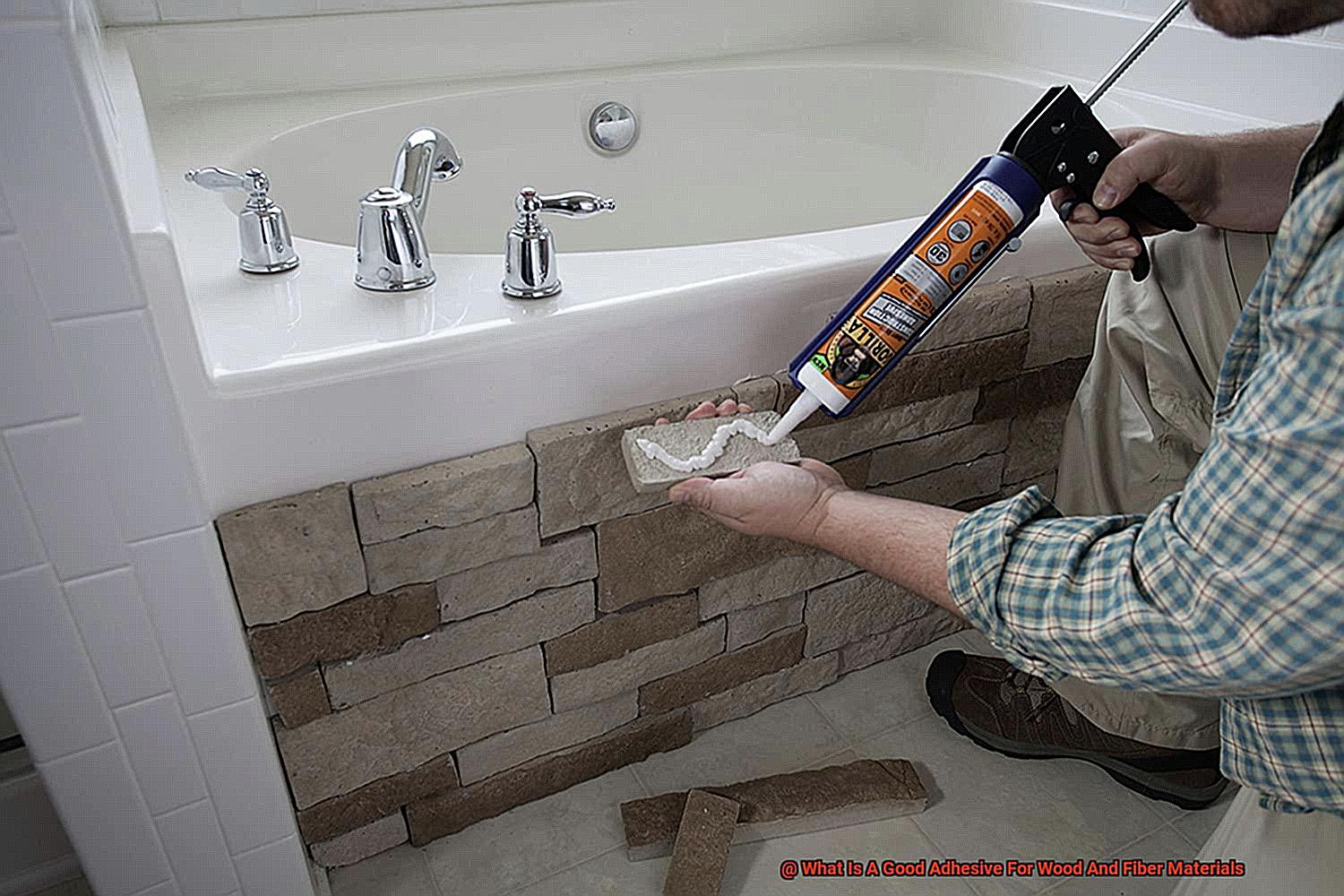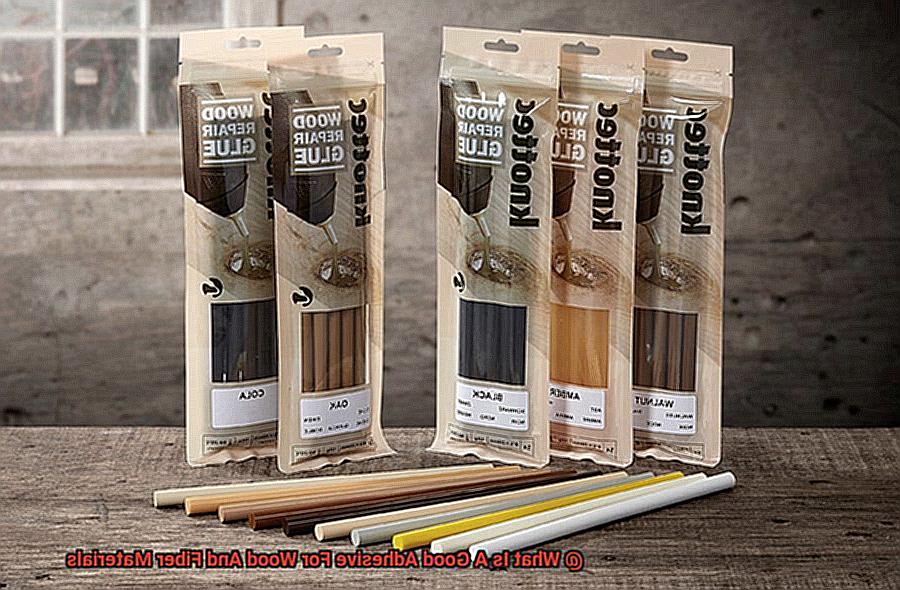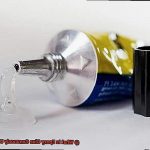Are you ready to tackle that woodworking project or DIY endeavor involving wood and fiber materials? Well, let me tell you, finding the perfect adhesive is like discovering buried treasure. It’s the secret ingredient that holds everything together and ensures your masterpiece stands the test of time. But with so many options out there, how do you know which adhesive will work its magic for your specific needs?
Let’s start with a classic: wood glue. This stuff is like a superhero in the world of adhesives. It’s strong, versatile, and can bond wood to wood or wood to fiber with ease. Whether you’re building furniture or crafting wooden goodies, wood glue has got your back. Plus, once it dries, you can sand it down and paint over it for a seamless finish. Talk about a match made in heaven.
But if you’re looking for something extra tough and durable, epoxy resin is where it’s at. This adhesive means business. It can handle heavy stress and withstand water or temperature fluctuations like a champ. That makes it perfect for boat building or outdoor furniture that needs to brave the elements.
Now, if speed is of the essence or flexibility is key, then grab yourself some cyanoacrylate glue—also known as super glue. This little wonder forms a strong bond in no time and works wonders on both wood and fiber materials. Just keep in mind that it may not be ideal for heavy-duty applications or things that require lots of movement since it can be a bit brittle.
But wait. There’s more. Adhesive tapes are also worth considering—especially for temporary projects or lightweight tasks. Double-sided adhesive tapes are quick and easy to use, making them popular for attaching fabric or carpeting to wooden surfaces or getting crafty with general DIY projects. Just remember that they might not have the same long-lasting power as liquid adhesives.
So there you have it—the lowdown on finding the right adhesive for your wood and fiber materials. Wood glue is the reliable go-to, epoxy resin brings the muscle, super glue gets things done in a flash, and adhesive tapes offer convenience for those quick fixes. By understanding what each adhesive brings to the table, you’ll be well-equipped to create woodworking wonders or tackle any fiber-related endeavor that comes your way. Now go forth and stick it to ’em.
What is Wood Glue?
Contents
Wood glue, the ultimate bonding solution for woodworking projects, is an essential tool for any craftsman. This versatile adhesive, also known as carpenter’s glue or PVA glue (polyvinyl acetate), is specifically designed to bond wood and wood-related materials together.
With its liquid, gel, and paste forms, wood glue offers a range of options for different applications. Its ability to penetrate porous surfaces effectively sets it apart from other adhesives. The natural fibers of wood readily absorb the glue, allowing it to seep into the material and create a strong bond. Whether you’re joining pieces of wood in furniture assembly or working on intricate woodworking projects, wood glue ensures a tight and durable connection.
Strength is another key feature of wood glue. When applied correctly, it can create bonds that are as strong as or even stronger than the wood itself. This ensures that your glued joints remain sturdy and reliable over time.
Moreover, many types of wood glue offer water-resistant properties, making them suitable for both indoor and outdoor use. While not all are fully waterproof, they do provide some level of resistance to moisture. This makes wood glue ideal for applications in areas with high humidity or direct exposure to moisture.

Wood glue’s versatility extends beyond bonding wood. It can also be used to bond other fiber materials such as MDF (medium-density fiberboard), particleboard, plywood, and even certain types of plastics. This flexibility makes it a popular choice among DIY enthusiasts and professional woodworkers alike.
To achieve the best results with wood glue, it’s important to follow the manufacturer’s instructions for application and drying times. Some glues may require clamping during the curing process, while others may not require clamping at all. By adhering to these guidelines, you can ensure that your projects are built to last.
Advantages of Using Wood Glue
If you’re seeking a dependable bonding solution, look no further than wood glue. This versatile adhesive offers a plethora of benefits that will elevate your woodworking skills to new heights. In this blog post, we will delve into the advantages of using wood glue and why it should be an indispensable tool in every woodworker’s arsenal.
Advantage 1: Unyielding Strength and Durability
Wood glue is specifically formulated to create an unbreakable bond between wood and fiber materials. It guarantees secure, long-lasting joints, providing the necessary strength for your woodworking projects. Bid farewell to weak bonds that compromise the structural integrity of your pieces.
Advantage 2: Unleashing Versatility
Wood glue is a true multitasker, capable of handling various applications. Whether you are joining pieces of wood, repairing broken furniture, filling gaps in wooden surfaces, or even attaching wood to other materials like fabric or foam, wood glue has got you covered. It is your ultimate ally in accomplishing diverse woodworking projects.
Advantage 3: Effortless Application
Applying wood glue is a breeze, regardless of your expertise level. Its liquid form allows for easy spreading with a brush, roller, or even your finger. Additionally, it boasts a relatively quick drying time, sparing you from waiting hours before proceeding with your project.
Advantage 4: Non-Toxic Formulations for Safety’s Sake
Safety always takes priority. Many wood glues available today are formulated to be non-toxic and safe for use. This attribute becomes particularly crucial if you have children or pets around who might come into contact with the adhesive. With non-toxic wood glues, you can work without worry and eliminate any potential health risks.
Advantage 5: Seamlessly Sanding and Finishing
Wood glue not only serves as a bonding solution but also as a finishing tool. Once dry, you can sand down any excess adhesive, creating a flawlessly smooth surface before applying paint or finish. This feature ensures that the glued area seamlessly integrates into the overall aesthetic of your project, leaving no trace of the bonding process.
Advantage 6: Cost-Effectiveness that Saves the Day
Wood glue is budget-friendly, making it an economical choice for woodworking projects. It is widely available in various sizes and forms, allowing you to select the most suitable option without breaking the bank. Moreover, a small amount of wood glue goes a long way, stretching its usage across multiple projects and maximizing its value.
What is Epoxy Resin?
Look no further than epoxy resin. This game-changing thermosetting polymer is a must-have for woodworking and fiber material applications.
What exactly is epoxy resin? It’s a powerful adhesive that hardens when mixed with a curing agent or catalyst. The result? A material that’s strong, durable, and resistant to moisture, heat, and chemicals. But what makes epoxy resin stand out from other adhesives?
First and foremost, epoxy resin boasts an impressive bonding strength. Whether you’re working with solid wood, plywood, particle board, MDF, or natural fibers like cotton or jute, epoxy resin creates unbreakable bonds. Say goodbye to weak joints and hello to sturdy connections.
But that’s not all – epoxy resin excels in filling gaps and voids. It effortlessly fills in small cracks or gaps in wood and fiber materials, ensuring a tight and secure bond. This makes it perfect for repairing damaged structures or enhancing the strength of your projects.
Not only does epoxy resin offer exceptional bonding and gap-filling properties, but it also stands up against various environmental factors. Its resistance to moisture makes it ideal for outdoor applications or high-humidity areas. Plus, it can handle extreme temperatures, allowing you to use it in scorching hot summers and freezing cold winters.
And let’s not forget about its versatility. Epoxy resin comes in different colors and finishes, so you can match it to the wood or fiber material you’re working with. Want a glossy finish? No problem. Prefer a matte or textured look? You got it. With epoxy resin, the possibilities are endless.
To ensure optimal results when using epoxy resin, make sure to follow the manufacturer’s instructions for proper mixing and application. Typically, it comes in two parts – the resin and the curing agent. Mixing them in the correct ratio guarantees the best curing and bonding properties.
Advantages of Using Epoxy Resin
Its exceptional strength and durability are among its most notable features. This adhesive forms a bond that can withstand heavy loads and resist moisture, ensuring longevity and reliability in various applications. Whether you’re building furniture or creating intricate fiber sculptures, epoxy resin provides the strength and durability needed to hold everything together.
In addition to its strength, epoxy resin offers excellent adhesion properties. It can bond to a wide range of materials, including wood, fiberglass, metal, and plastic. This versatility makes it a popular choice for woodworking and construction projects where different materials need to be joined together securely.
One of the standout advantages of epoxy resin is its resistance to chemicals and solvents. Unlike other adhesives that may deteriorate or lose their bonding capabilities when exposed to harsh substances, epoxy resin remains intact and reliable. This makes it perfect for applications where the adhesive may come into contact with chemicals or cleaning agents.
Another advantage of using epoxy resin is its remarkable heat resistance. It can withstand high temperatures without melting or losing its bonding capabilities, making it suitable for applications where heat resistance is required. For example, in the construction of furniture or kitchen countertops, epoxy resin ensures a strong and durable bond even under extreme temperature conditions.
Epoxy resin also excels at filling gaps and creating a smooth surface. Its low viscosity allows it to flow easily into cracks and gaps, ensuring a seamless finish once cured. Furthermore, epoxy resin offers good dimensional stability, meaning it doesn’t shrink or expand significantly after curing. This ensures that the bonded materials maintain their shape and structural integrity over time.
Moisture resistance is another outstanding feature of epoxy resin. It is highly resistant to moisture and humidity, preventing any potential damage or weakening of the bond due to exposure to water. This makes it an excellent choice for applications where moisture resistance is crucial, such as outdoor furniture or marine applications.
Lastly, epoxy resin offers a wide range of formulations, allowing users to choose the most suitable type for their specific application. With different viscosities, curing times, and color options available, epoxy resin provides flexibility and customization options to bring creative visions to life.
What is Polyurethane Adhesive?
In the world of woodworking and construction, finding the perfect adhesive can make all the difference in creating strong and durable bonds. Among the vast array of options available, one adhesive reigns supreme with its exceptional strength, versatility, and durability: polyurethane adhesive. Let’s delve into the world of polyurethane adhesive and uncover why it is hailed as the superhero of glues.
Unrivaled Bonding Power:
Polyurethane adhesive boasts an unrivaled ability to bond various materials, including wood, fiber, metal, plastic, and even concrete. Regardless of whether you’re working on a woodworking project or a construction endeavor, this adhesive delivers a reliable and long-lasting bond that surpasses the strength of the materials being joined.
Defying Water:
One of the standout advantages of polyurethane adhesive is its remarkable water resistance. It can withstand exposure to moisture, humidity, and even water immersion without compromising its bond strength. This makes it ideal for both interior and exterior applications where bonded materials may frequently encounter environmental conditions or water exposure.
Flexibility and Resilience:
Polyurethane adhesive possesses exceptional flexibility and impact resistance. It can absorb vibrations and movements without causing the bond to fail. This property is particularly significant when bonding wood and fiber materials that may expand, contract, or bend due to changes in temperature or humidity.
Strength that Matters:
With its superior strength properties, polyurethane adhesive ensures a secure and durable connection between bonded materials. It forms a bond that is stronger than the materials themselves, making it suitable for heavy or load-bearing structures such as furniture or structural beams.
Formulations for Every Need:
Polyurethane adhesive is available in various forms – liquid, paste, and pre-catalyzed options – catering to different application requirements. Liquid forms are commonly used for general-purpose applications, while paste forms are ideal for vertical or overhead bonding. Pre-catalyzed options eliminate the need for mixing and provide faster curing times, making them perfect for time-sensitive projects.
Advantages of Using Polyurethane Adhesive
In the world of woodworking and construction projects, having a reliable adhesive is crucial. Look no further than polyurethane adhesive, the superhero of glues. With its exceptional bonding strength, flexibility, water resistance, versatility, and more, it’s not surprising that professionals in the industry swear by this adhesive. In this blog post, we will delve into the advantages of using polyurethane adhesive for wood and fiber materials, and explore why it is the ultimate choice for any project.
Exceptional Bonding Strength:
Polyurethane adhesive forms a bond that surpasses the strength of the materials being joined. It effectively bonds different types of wood and fiber materials, including hardwood, softwood, particleboard, MDF, plywood, and various natural and synthetic fibers. Whether you’re working on furniture manufacturing, cabinetry, flooring installation, or construction projects, polyurethane adhesive ensures a secure and long-lasting connection.
Flexibility:
The standout advantage of polyurethane adhesive is its remarkable flexibility. This attribute makes it perfect for bonding materials that may expand or contract due to temperature changes or moisture absorption. The adhesive can accommodate natural movements without compromising the bond strength, reducing the risk of joint failure or delamination over time.
Water Resistance:
No need to worry about moisture ruining your project. Polyurethane adhesive boasts excellent water resistance, unlike many other adhesives on the market. It remains strong even when exposed to moisture or water. This makes it a top choice for outdoor furniture, marine applications, or areas prone to high humidity.
Versatility:
Polyurethane adhesive is incredibly versatile. It can bond wood to wood, wood to fiber, or even fiber to fiber. This versatility makes it suitable for a wide range of applications in various industries. From construction to automotive interiors, there’s no limit to what this adhesive can do.
Gap-Filling Capabilities:
Working with uneven or rough surfaces? No problem. Polyurethane adhesive has excellent gap-filling capabilities. It can fill in small gaps or irregularities between the bonded surfaces, creating a stronger bond by maximizing the contact area between the materials.
Chemical Resistance:
Polyurethane adhesive exhibits good resistance to various chemicals, including solvents, oils, and fuels. This property makes it ideal for applications where exposure to harsh chemicals is expected, such as industrial equipment or automotive parts.
Ease of Use:
Polyurethane adhesive is relatively easy to work with. It is available in different forms, including liquids and pre-catalyzed adhesives, allowing users to choose the most convenient option for their specific needs. Additionally, it has a moderate curing time, providing sufficient working time for assembly before the adhesive sets.
What is Contact Cement?
When it comes to adhesive superheroes, contact cement reigns supreme. With its remarkable ability to create an instant bond and withstand the toughest conditions, this glue is a game-changer in the world of woodworking, construction, and crafts.
Here, we will explore the fascinating world of contact cement, delving into its uses, advantages, and why it is the go-to choice for professionals and DIY enthusiasts alike.
Instant Bonding Power:
Unlike other adhesives that require tedious drying time or clamping, contact cement possesses an impressive superpower – it bonds instantly upon contact with the surfaces being joined. Say goodbye to waiting around and hello to efficient project completion.
Versatility at Its Finest:
Contact cement is not limited to a single material. It is a versatile hero capable of bonding wood to wood, wood to fiberboard, and even fiberboard to fiberboard. Whether you are laminating countertops, installing veneer, or assembling furniture, contact cement has your back.
Unyielding Strength and Durability:
Once cured, contact cement forms an unbreakable bond that can withstand heat, moisture, and most chemicals. It acts as a shield against harsh conditions and heavy use. Regardless of what your project encounters, contact cement ensures a long-lasting union.
Temperature Resistance:
Contact cement remains strong when faced with temperature fluctuations. Whether you are working indoors or outdoors, hot or cold environments won’t faze this adhesive warrior – it remains stable and keeps your project intact.
Liquid or Spray: Your Choice.
Contact cement is available in both liquid and spray forms. The liquid form allows for precise application using a brush or roller, while the spray form offers convenience and ease. Whichever form you choose, rest assured that they deliver similar bonding properties.
Safety First:
As with any adhesive superhero, contact cement does come with a word of caution. It is a solvent-based adhesive that contains volatile organic compounds (VOCs). Proper ventilation and following the manufacturer’s instructions are essential to ensure a safe and enjoyable experience.
Advantages of Using Contact Cement
Look no further because contact cement is here to save the day. This incredible adhesive is packed with advantages that will revolutionize your woodworking and crafting game. Let’s dive into the world of contact cement and explore why it’s the superhero glue you need in your toolbox.
Advantage 1: Unbreakable Bond
Contact cement is renowned for its unbeatable bonding power. Once applied and dried, it forms an instant and permanent bond between two surfaces. Say goodbye to worrying about your creations falling apart. This superhero glue can withstand a significant amount of stress and strain, ensuring your projects stay intact for years to come.
Advantage 2: Versatility at Its Finest
Imagine having one adhesive that can handle a wide range of materials. Well, contact cement does just that. From wood and fiberboard to laminate, leather, and rubber, this glue can tackle it all. No more searching for different adhesives for each material – contact cement has got you covered.
Advantage 3: Flawless Finish
When it comes to aesthetics, contact cement is the champion. It leaves no visible residue or marks, providing a seamless finish that will make your projects look professional and polished. Perfect for those delicate wood or fiber materials that require a clean and flawless appearance.
Advantage 4: Ready for Anything
Moisture? Heat? No problem. Contact cement is resistant to both. Once cured, it becomes waterproof and can withstand high temperatures without losing its bonding strength. So whether you’re working in a humid environment or expecting exposure to water, this adhesive has got your back.
Advantage 5: Easy Peasy
Let’s face it – we all appreciate convenience in our lives. Contact cement offers just that. It comes in various forms, such as liquid, gel, or spray, giving you the freedom to choose the best option for your project. Plus, no clamping or additional tools are needed for bonding, saving you precious time and effort.
Advantage 6: Speedy Gonzales Bonding
Time is of the essence, especially when you’re in the middle of a project. With contact cement, you won’t have to wait forever for it to dry or cure. Just apply it to both surfaces, let it dry for a few minutes, and voila. You can press them together to create an immediate bond. Perfect for those fast assembly or repair projects.
Advantage 7: Flexibility Matters
We all make mistakes or need to make adjustments along the way. Contact cement understands that, which is why it offers flexibility in repositioning or adjusting the bonded surfaces before the adhesive fully sets. Say goodbye to crooked alignments and hello to precise positioning.
Conclusion
When it comes to bonding wood and fiber materials, finding the right adhesive is crucial.
Fortunately, there are several options available that can provide strong and durable bonds. One popular choice is polyvinyl acetate (PVA) glue, which is known for its versatility and ease of use.
Another excellent option is epoxy resin, which offers exceptional strength and resistance to moisture. Additionally, cyanoacrylate adhesive, commonly known as super glue, can be a reliable choice for smaller woodworking projects.
Therefore, it’s important to carefully consider your needs before making a decision.






